A Feast For All Seasons
“Repeatedly poring through Prospero’s introduced me to a far greater range of flavors and ingredients than I’d thought possible. To this day, whenever I come across the book’s recipe for Venetian Pastitsio, I salivate: it’s a huge pie, filled—like the proverbial kitchen sink—with chunks of game, pork, organ meats, fowl, and spiced with cinnamon and cloves, layered with cheeses. Not at all like the marinara-sauced meat and pasta dish of pastitsio I’d had in my Greek restaurants-in-exile, and not at all like the much simpler but truly glorious pastitsio I now make with bechamel, lamb and beef, Greek pasta, and kasseri cheese when I can find it.”—William A. Balk, Jr.
Epicurus’ Porch
By William A. Balk, Jr.
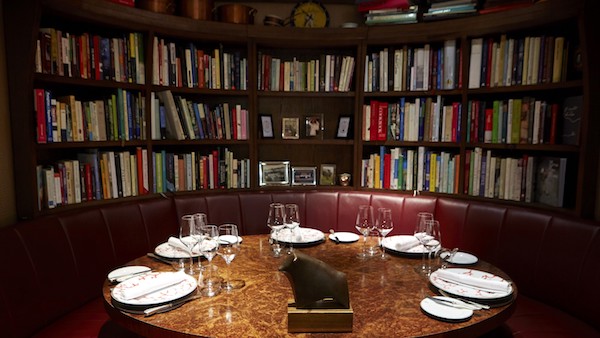
ELKO South Carolina—(Weekly Hubris)—November 2019—My sister Libby was rifling through the kitchen drawers, the ones that seem to catch all the “where-does-this-go?” stuff: batteries, wine corks, rubber bands, extra mason jar lids, stubby lead pencils. Several of those drawers actually hold useful things, and she was looking for the folders of carefully saved family recipes, special dishes perfected over decades, stored here among long-neglected guides to brewing beer and making wine.
Libby was looking for Mama’s version of the classic Angel Biscuits, that exquisite blend of yeast roll and baking powder biscuit that has been on our Thanksgiving table for generations. It is that time again, so the planning must begin.
Libby and Tom have assumed the mantle this year, hosting the extended family—relations by blood, history, and affection—and doing it properly necessitates digging up all the old holiday recipes that are required for a real Thanksgiving. There are, in fact, a number of files of these family recipes, some from pit-masters and camp cooks among our kin, others from mothers and grandmothers and family cooks who worked in kitchens with wood stoves, and some from our parents’ years of exploration and experimentation with the glorious products of our local farms and waters and woodlands.
Most of the recipes, though, were gleaned from published sources—cookbooks, articles, backs of packages—taken and tried, altered here and there, adapted to personal tastes and preferences, adjusted for family size and youthful appetites. There are years of detailed records of experiments with varying ingredients, quantities, cooking times, preparation, all leading up to the perfected recipe.
It certainly is not unique to our family, this hoarding of gustatory inspiration and guidance; many families have such collections of recipes, and more than a few cookbooks over the years have been published from such family collections, cookbooks which, in turn, provide some of the most interesting and innovative fodder for other cookbook writers in developing new culinary ideas for publishing more broadly.
I admit to a particular affection for cookbooks, especially those with family recipes and stories, or with contributions from club members, or offering the beloved dishes of a particular community. I will also admit with a little embarrassment that I enjoy those sumptuous picture cookbooks that clearly are designed to inspire envy and fantasy more than any urge to run to the kitchen to prepare a quick Canard à la Presse for supper.
Some cookbooks, however, have become more than recipe collections for me, having become almost iconic reference points for one’s maturing tastes and broadening experience, touchstones in developing a view of the world and one’s approach to living.
Such a book, of course, is the original Mastering The Art of French Cooking, which Julia Child wrote with Simone Beck and Louisette Bertholle in 1961. The book is inseparable from Julia’s iconic television show, The French Chef, which began in 1963, in having brought to me and huge numbers of Americans a new understanding of cookery.
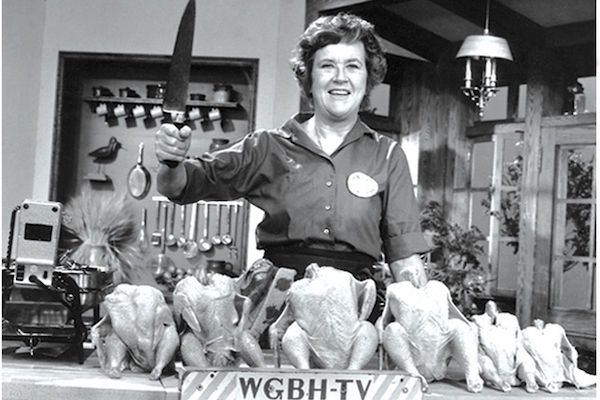
Very different, indeed, is Joy of Cooking, first published in 1936, by Irma S. Rombauer. For me, and I suspect for many other cooks, Joy of Cooking made the complexities of cooking (the various measurements, the incomprehensible variety of cuts of meat, the reasons each method of leavening works, etc.) understandable and accessible: plus, they were provided in a comprehensive single (if hefty) volume. Recipes’ relationships to each other became obvious, too, and an earnest reader might begin to develop a kind of unified theory of cooking by reading and understanding Rombauer’s chapters.
There are others, too, which over the years have become vital to my philosophy of food and eating, even if they are not quite up to the life-defining role that Julia Child and Irma Rombauer have played. I think in particular of John Martin Taylor’s Hoppin’ John’s Lowcountry Cooking, published in 1992, which is in no small part one of the reasons Charleston became one of America’s most prominent food cities. John is a culinary historian, not a chef, and this book represents a scholar’s understanding of my native region’s incredibly rich culinary history. And, significantly, it is partly through his book that John and I became friends.
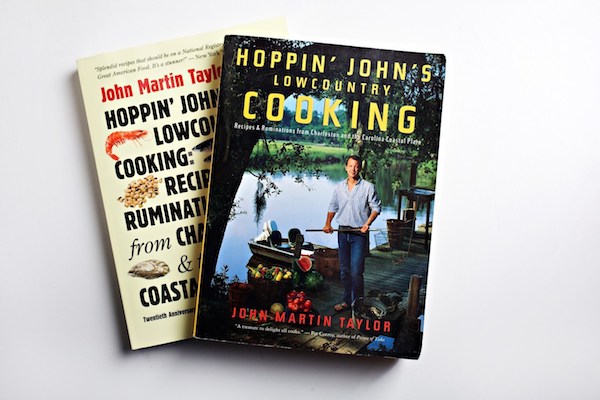
Hoppin’ John’s is persistently the resource for chefs using Southern and Lowcountry ingredients and processes. For understanding rice, appreciating grits, and making cornbread, there is no better book; for crabs, shrimp, for pork, John shows it all. I return to the book so frequently, I’m on my third worn copy now.
Mediterranean cuisine is much bruited as healthy; sometimes it seems forgotten that it is also delicious. Thus it was a quarter century ago I came across Prospero’s Kitchen: Island Cooking of Greece, which explores the “off-shore” cooking of Greece. I had gotten to know Greek food only from the small Greek restaurants I’d visited in several cities, and I liked very much the general tastes and ingredients I tried. It was not fancy food. But repeatedly poring through Prospero’s introduced me to a far greater range of flavors and ingredients than I’d thought possible. To this day, whenever I come across the book’s recipe for Venetian Pastitsio, I salivate: it’s a huge pie, filled—like the proverbial kitchen sink—with chunks of game, pork, organ meats, fowl, and spiced with cinnamon and cloves, layered with cheeses. Not at all like the marinara-sauced meat and pasta dish of pastitsio I’d had in my Greek restaurants-in-exile, and not at all like the much simpler but truly glorious pastitsio I now make with bechamel, lamb and beef, Greek pasta, and kasseri cheese when I can find it.
It was some 20 years after I’d first gotten to know Prospero’s Kitchen that I was made aware that its renowned author, Diana Farr Louis, was, in fact, my colleague and fellow contributor to the international journal, “Weekly Hubris”! And even further, Diana was the sister of my late Beaufort friend Tom Farr, whose wife, Terry, was my coworker and friend in the bookstore on Bay Street! Any day now, I expect to discover that the fabulous Diana, who has lived in Athens and on the island of Andros for many years, is a distant cousin.
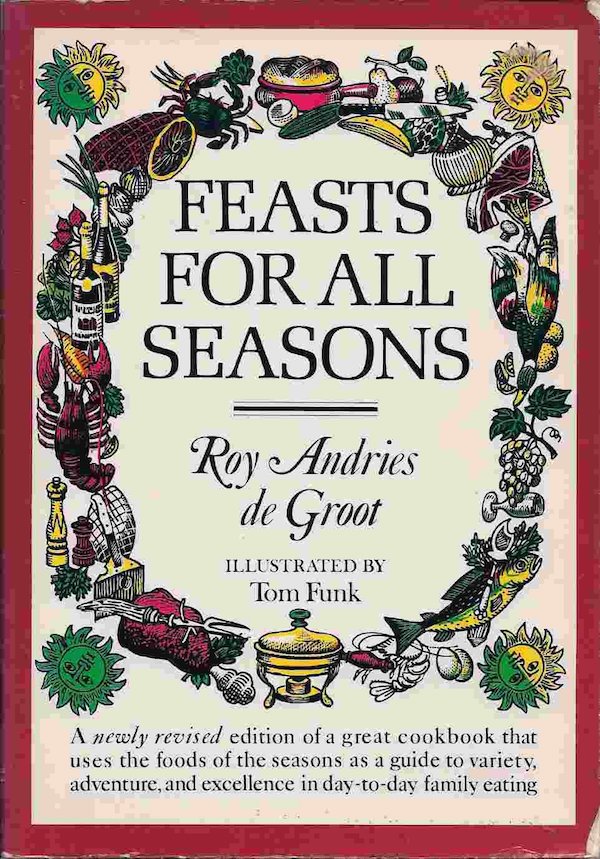
I can remember when gazpacho, the classic Spanish cold soup, became a magical revelation to me. No longer the blender-smoothed vegetable soup with a bit of spice that I had been served so often before, this was a very chunky assortment of the best summer garden vegetable, served in a light tomato sauce thickened with bread steeped in olive oil and sherry vinegar, and mashed with garlic. It is then left to merge flavors overnight into the most luscious cold soup ever . . . . I always make it in one- or two-gallon batches, because I find I must repeatedly (hourly!) test its flavor development, and always that requires multiple spoonsful.
This miraculous recipe was one of the first I tried when, 40 years ago, I was given Feasts For All Seasons, by Baron Roy Andries de Groot. De Groot was a British-born American food writer for “Esquire,” “Holiday,” “Gourmet,” and others, a gourmand/gourmet, a wine connoisseur, and a food and wine critic.
“The Baron” (a family title given up when he moved to the United States, but which seems to have been affectionately applied among friends) lost his sight early in life, a fact which seems to have influenced some of his approaches to cooking. I learned from him, for instance, the technique (well known by professional cooks, of course, but not by me) of testing the doneness of meat by pressing it, sensing its degree of firmness. I find this method far more precise than timing or appearance—though not so precise as the now-available instant-read thermometer.
De Groot’s book is a source of constant inspiration, full of ideas for meals, recipes for unusual preparations, superb wine pairing suggestions, and concepts for feasts and family meals far beyond the usual. Some are complex, others truly simple; all are particularly full of flavor and engage the mind as well as the taste buds.
Perhaps I should confess that I once let my enthusiasm for Baron de Groot’s culinary adventurousness get the better of me. In addition to Feasts For All Seasons, he also wrote The Auberge of the Flowering Hearth, a lovely memoir of simple seasonal French cookery, and Revolutionizing French Cooking. It was the latter title which led me astray.
In the mid 1970s, a revolution in food and health led by French chefs, such as Michel Guérard and the brothers Troisgros, was the talk of foodies all over the world. Everyone was in a tizzy about the overthrow of la grande cuisine and its replacement by la nouvelle cuisine and cuisine minceur. Menus shifted to the lightest of preparations, sauces became delicate reductions, vegetables were only barely cooked to retain their texture.
Many preparations were absurdly complicated and some of the new dishes ultimately disappointed unsuspecting diners; eventually, the revolutionary became normal and the most interesting and successful recipes and approaches of the new light French cuisine were adopted into our standard list of favored foods.
Baron de Groot was swept up in the revolution, though and, in 1976, published Revolutionizing French Cooking to bring the new cuisine minceur to the American home cook. By now devoted to de Groot’s approach, I rushed to buy the book and absorb the tenets of this new way of cooking and, indeed, of living.
I studied de Groot’s deconstruction of a basic salad; his explanation for particular ingredients for sauces for meats; the necessity of finding new ingredients and using them in new ways.
I remember reflecting on a suggestion to substitute inert ingredients in some recipes to obviate calories and make the dish lighter. While animal fats and vegetable oils are heavy in calories—even the worshipped olive oil! —an oil derived from mineral sources is inert insofar as the body is unable to absorb calories from it.
This, I thought, I can do easily! I leapt up, prepared my first nouvelle cuisine salad using mineral oil instead of olive oil in the dressing, and sat down to eat it. The salad was fine, of course, but I was disappointed at how bland the vinaigrette dressing was. Oh, well, I thought . . . so much for that theory.
An hour or so later, however, the folly of consuming several tablespoons of mineral oil was made abundantly clear. I have ever since referred to la nouvelle cuisine as “the laxative diet.”
These favorites among my cookbooks all share a personality, a particular approach derived from the unique experience and interests of the author. Each book, each recipe reflects the desire to welcome the reader, the cook, the diner into a rich part of the writer’s life. And when I read these books and cook from them, I do indeed feel a connection to each of these cookbook friends.
In all the slips of lined paper and newspaper clippings in our kitchen drawers there still remain a number of family recipes that are our go-to versions of treasured dishes served over many years to countless family and friends. I thought I’d share here our version of Pilau.
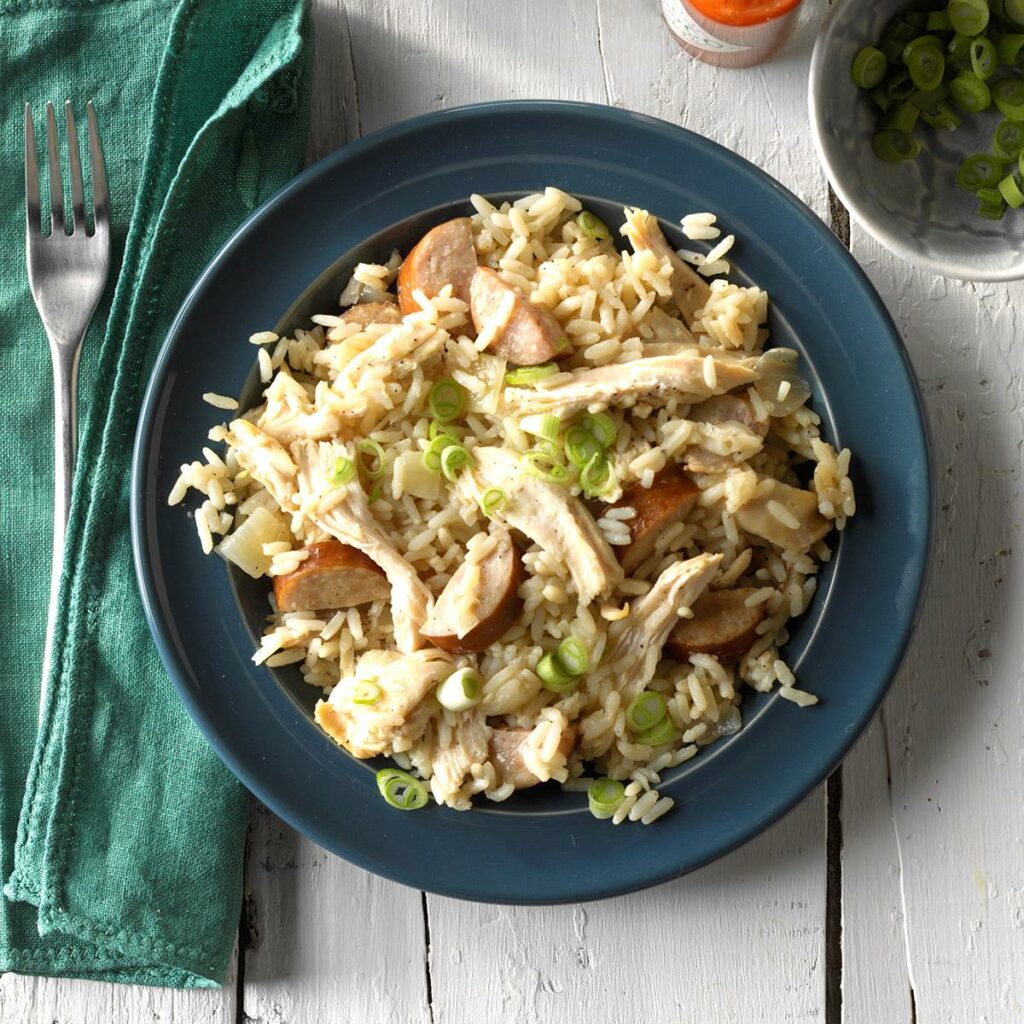
This is a classic one-pot rice dish from the Lowcountry. You will find versions called, variously, pilau, perlo, pileau, pilaf, and perloo. You will also find recipes which use chicken or sausage or pork or fowl or game. Or seafood. You will find it also called Bog, as in “Chicken Bog.” We have made it using most of the afore-mentioned meats, but chicken is the meat most often used in this recipe.
And, finally, I should mention that the family recipe was developed for large-batch preparation. I have adapted the recipe so that a typical family meal for 6 can be prepared.
![]()
Chicken Pilau
For 6
Preparation Time
For Chicken and Broth, 10 minutes
For Pilau, 15 minutes
Cooking Time
For Chicken and Broth, 1½ hours
For Pilau, 20 minutes + resting
Ingredients
For Chicken and Broth
1 medium chicken, whole
2 stalks celery, halved
1 medium onion, quartered
2 tsp salt
1 tsp ground black pepper
1 tsp Garlic powder
1 tsp paprika
½ tsp red pepper flakes
1 bay leaf
4 cups water
For Pilau
1 medium onion, chopped
1 large stalk celery, chopped
1 large bell pepper
chopped meat from boiled chicken
1 tsp salt
2 cups uncooked long grain rice
4 cups broth
For the Broth and Chicken
Remove giblets, etc., from the chicken cavity, clean and rinse chicken, place in a large heavy pot with a tight-fitting lid. Add water, celery, onion, salt, and aromatics. Bring to a slow simmer over medium heat, and when it reaches the boil, reduce the heat to medium low, cover tightly, and simmer gently for an hour.
Remove the chicken and let it cool. When you can handle it, remove the skin, and then remove the meat from the bones, cut into bite-sized pieces, and reserve the meat.
Strain the broth and either add additional broth or water to make the amount equal to 4 cups, or remove enough extra broth to make 4 cups of broth. Return the 4 cups of strained broth to the pot.
Add the salt and bring the broth to a boil. Once boiling, add the rice, vegetables, and the chicken meat, reduce the heat to medium low, cover tightly, then cook for 20 minutes. Do not lift the lid or stir more than twice, and then only very quickly: escaping steam will leave the rice dry. After 20 minutes, stir the rice and chicken, cover and let rest for 30 minutes before serving. (Additional liquid will yield a softer, juicier result; the term “bog” tends to be applied to those versions which are more moist. Under no circumstances use less than 4 cups of liquid for 2 cups of rice.)


9 Comments
judy
I never knew that perlau and pilaf shared “gustatory” roots. Did I use “gustatory” correctly? It’s such a robust word, and one that has never rolled from my tongue.
William Balk
Judy, “gustatory” is fine, referring to taste – and it is a robust word! And, yep! Amazing that all the world’s rice-consuming cultures came up with some variation on this Lowcountry dish – and that so many have similar names! Delish, regardless!
Jane Miller
Those angel biscuits always disappeared before anything else! BTW, I have the delectable Betty Balk Dressing recipe if you can’t find it. I have made it for Christmas the past 15 years, since I overcame my apprehension and asked for it.
Diana
Dearest Will, I clicked on your column thinking of our shared love of food and cookbooks but never dreamed I’d find one of my own mentioned and with such gusto (never mind gustatory) and affection. You have brought tears to my eyes and only fanned my hopes that we will indeed meet soon. Meanwhile, I would so love to see those other recipes you mention tucked away in drawers. And, it struck me very funny that the things that have collected in your drawers are almost identical to what I have amassed in a large sieve on the kitchen table — corks, batteries, rubberbands, etc. Thanks for this very enjoyable essay. xox
Will
Jane, I’m pretty sure I saw the recipe for dressing when I was going through those drawers and files, but I didn’t pull it out. If I don’t have it, I’ll ask you for it. I’m so pleased ya’ll will be at Thanksgiving!
Will
Diana, dear one, it was a delight to share my affection for Prospero’s Kitchen with more readers, and to emphasize just how strong the personal connection is in making favorites among cherished recipes. And, I must say, if your large sieve is anything like our catch-all drawers, you discover that things only go in, adding to the clutter. But I always know just where to look for that little missing ‘thing’ that suddenly is so necessary. Thank you for reading the piece and for sharing it with your dear ones.
Jane Miller
Will, For years I have been saying you should write a book. That overflowing drawer and the recipe files are the perfect place to start!! Even if it’s just for family. Those recipes, many of which I have had the pleasure of sampling, deserve to be preserved for posterity. We are so excited about Thanksgiving and can barely wait!
Jane Miller
PS – There are a lot of stories that could go along with those recipes as well!
Will
Thanks, Jane…..taken under consideration!